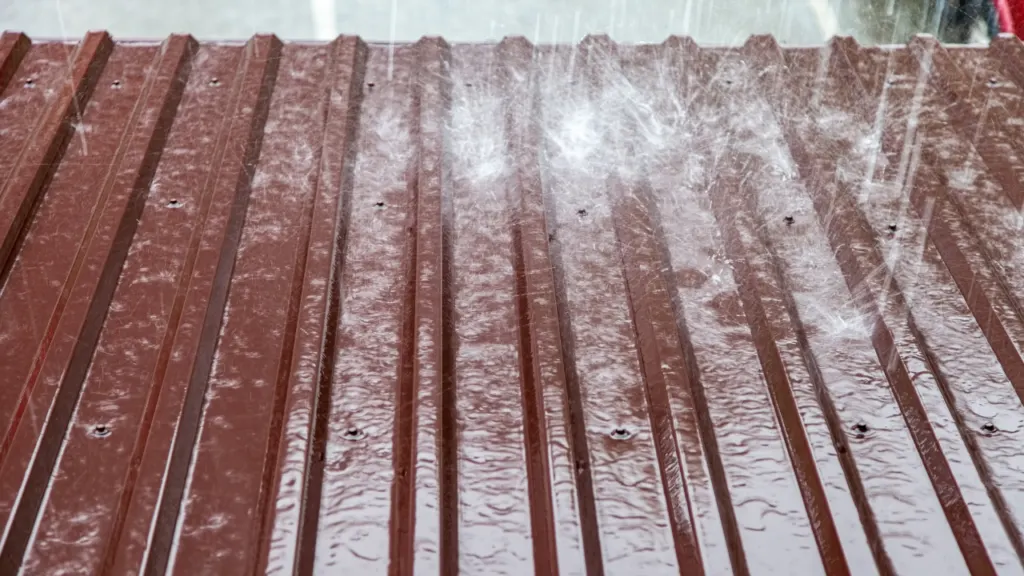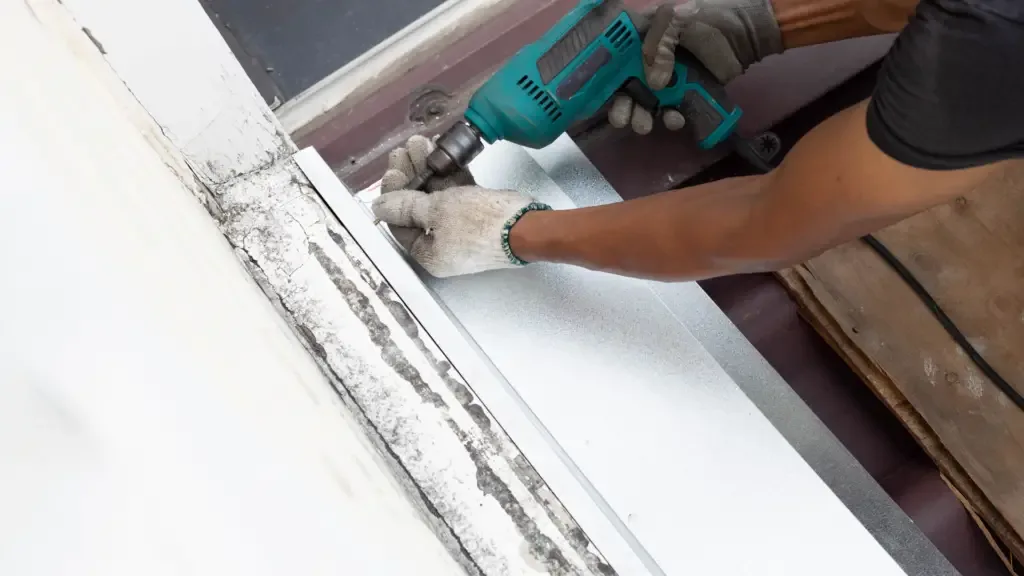
Metal roofs are known for their durability and longevity, making them a popular choice for homeowners. However, like any roofing system, metal roofs are not immune to leaks. Leaks can occur for various reasons, from poor installation to weather damage.
In this article, we’ll explore the common causes of metal roof leaks and provide you with expert tips on what to do about it. We’ll discuss how to identify the signs of a leak, the importance of regular maintenance, and steps you can take to fix the issue.
Whether you’re a homeowner, contractor, or DIY enthusiast, this guide will equip you with the knowledge and tools to tackle metal roof leaks and keep your home protected from water damage. So, let’s get started and ensure your metal roof remains leak-free for years to come!

Causes Of Metal Roof Leaking
Improper Installation
One common cause of metal roof leaking is improper installation. If you’ve hired a contractor without adequate experience or training, they may have made mistakes during the installation process, which could lead to leaks.
Ensure you always work with a reputable contractor who specializes in metal roofing.
Flashing Issues
Flashing issues can cause leaks around roof transitions, intersections, and other vulnerable areas. Ensuring that your roof’s flashing is properly installed, including counter flashings, Z flashings, reglets, and pitch pans, can help prevent leaks.
Sealant and Caulking Problems
Using the correct sealant and caulking materials is essential for preventing leaks in your metal roof. Make sure to use quality silicone caulking and avoid using tar or other inferior products.
Additionally, be mindful of the adhesion and cohesion properties of the sealant to prevent capillary action.
Fasteners and Screws
Using the right type of fasteners and screws, such as metal roofing screws, is critical for maintaining the durability of your metal roof. Over-driven screws or incorrect fastening techniques can lead to leaks.
Make sure your screws have a rubber washer to form a tight seal.
Seams and Overlaps
Leaks can occur at seams and overlaps if they aren’t properly sealed. Applying proper sealants or butyl tape and ensuring all joints are secure can prevent water from infiltrating these areas.
Metal Roof Panels
Ensure your metal roof panels are in good condition and properly installed. A poorly fitted or damaged panel can lead to leaks. Regular visual inspections can help identify and address any issues.

Ventilation and Vent Issues
Leaks can also result from improperly installed or damaged vents. Issues with ventilation can cause moisture buildup in your attic, leading to water damage. Inspect your vents and address any problems to avoid leaks.
Corrosion and Rust
Corrosion and rust can weaken your metal roof, increasing the likelihood of leaks. Regular maintenance and periodic inspections can help keep your metal roof in good condition.
Age and Lifespan
As your metal roof ages, it becomes more susceptible to leaks. Be mindful of your roof’s lifespan and consider replacing it if necessary.
Severe Weather
Severe weather, such as hail and high winds, can cause damage to your metal roof, leading to leaks. After a storm, inspect your roof for signs of damage and address any issues promptly.
Poor Drainage and Gutters
Poor drainage from clogged or improperly installed gutters can cause water to pool on your roof, leading to leaks. Ensure your gutters are the appropriate size and are well-maintained to prevent issues.
By understanding and addressing these common causes of metal roof leaks, you can help prolong the life of your roof and protect your property from water damage.

What To Do About Metal Roof Leaks
Identify The Leak Source
When dealing with a leaking metal roof, the first step is to perform a visual inspection to identify the leak’s source. Look for signs of water infiltration in the attic and examine the metal roof panels, fasteners, and seams for any damage or deterioration.
Keep an eye out for loose screws, open seams, or degraded sealant that might be allowing water to seep through.
DIY Fixes And Repairs
Once you have identified the cause of the leak, you can undertake some DIY fixes and repairs. For instance, if you discovered loose screws, you can tighten or replace them to secure the metal roof panels.
If the problem is poor sealant or open seams, you can use high-grade epoxy resin, caulk, or butyl tape to seal the affected areas. However, remember to utilize a knowledgeable and cautious approach when carrying out DIY repairs to avoid causing further damage to your roof.
Hiring A Roofing Contractor
In case you are unsure about the cause of the leak or do not feel confident in performing DIY repairs, consider hiring a roofing contractor. A professional roofing expert can locate the source of the leak, assess the extent of water damage, and recommend the most suitable course of action for repair.
Hiring an experienced contractor also ensures your roof is repaired efficiently and with minimal risk of causing more issues in the future.
Regular Maintenance And Inspections
Prevention is always better than cure. To minimize the risk of leaks in your metal roof, it is essential to perform regular maintenance and inspections. Remove debris from your roof, ensure proper drainage, and check for signs of wear and tear in the metal panels, fasteners, and sealant.
Regularly inspecting the sealant in areas such as metal ridge caps, Z-flashings, and roof transitions can help keep your metal roof in top condition and prevent leaks.
Roof Replacement Or Overhaul
As a last resort, if your metal roof is severely damaged, old, or being prone to continuous leaks, it might be time to consider a roof replacement or overhaul. Consult with a roofing contractor who specializes in metal roofing systems to discuss your options for either a full replacement, restoration, or added protection with a commercial roof coating.
Keep insurance in mind as well, since some policies may cover part of the cost of roof repairs or replacement.

Preventive Measures For Metal Roof Leaking
Proper Installation
To prevent metal roof leaks, it’s essential to ensure that your metal roof is correctly installed. Hiring a reputable contractor with experience in metal roofing will help ensure that the installation process is done correctly.
This includes properly securing joints and overlaps, and applying sealant or butyl tape where necessary.
Quality Materials And Components
Using quality materials and components is crucial to avoid metal roof leaks. When selecting materials, look for ones that offer durability, strength, and resistance to rust and corrosion.
This also applies to your roofing fasteners and screws, which should be designed explicitly for metal roofing and properly tightened during installation.
Regular Maintenance And Inspections
Performing regular maintenance and visual inspections of your metal roof is crucial to catch any issues before they develop into leaks. Keep an eye out for loose fasteners, missing sealant, and shifts in roofing panels.
If you’re not comfortable inspecting the roof yourself, consider hiring a roofing expert to perform annual check-ups to detect potential problems.
Addressing Drainage And Gutter Issues
Poor drainage can lead to water pooling on your metal roof, causing leaks over time. Make sure your gutters are properly installed and sized for your roof to prevent this problem.
Regularly clean your gutters to avoid clogs that could lead to water buildup and leakage. If you notice issues with drainage, consult with a professional to identify and address the problem promptly.
Weatherproofing And Corrosion Prevention
Protecting your metal roof from severe weather and corrosion is vital for avoiding leaks. Regularly inspect your roof for signs of rust and damage caused by storms or debris.
Seal any joints or overlaps with caulk or butyl tape as needed, and replace any corroded fasteners or screws. This will not only prevent leaks, but also extend the lifespan of your metal roof.

